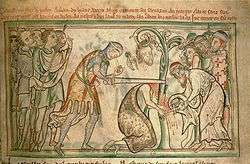Passio Albani

The Passio Albani, or Passion of Saint Alban, is medieval hagiographic text about the martyrdom of Saint Alban, the protomartyr of Roman Britain. The author is anonymous, but it is thought to have been originally authored or commissioned by Germanus of Auxerre, probably sometime during the 5th or 6th century. It currently survives in three different recensions and six separate manuscripts located throughout Europe, and forms the basis for all subsequent retellings of the Saint Alban martyrdom, from Gildas to Bede.
Manuscripts and Recensions
The Passio has survived in six separate manuscripts located throughout Europe. In 1904, The German scholar W. Meyer identified three different recensions of the manuscript, which he named T, P, and E.[1] The T manuscript is located in Turin, the P manuscript in Paris, and the E manuscripts, of which there are four copies, are located at the British Library, Gray's Inn London, Autun France, and Einsiedeln Switzerland.[2]
Meyer identified the T or Turin manuscript as the oldest version of the Passio, and the basis for all other recensions. He believed it was produced at the end of the eighth century at Corbie.[2] Meyer did not believe that the original version of the Passio, the one set down by Germanus on tituli, had survived, and he assumed that the T version was therefore the oldest and most accurate version of the lost original. He postulated that the Turin manuscript was later abridged to form text E, which was then redacted to form the Paris text.[1] This led him to assume that the E version was merely an abridgment of the Turin manuscript, and he edited it only in an abriged form as part of his 1904 survey.[3]
Meyer's view was the standard interpretation for nearly 100 years, which had major implications in how later historians interpreted the historicity of Saint Alban and dated his martyrdom.[2] It wasn't until 2001 that Richard Sharpe examined the E manuscripts and argued that the Turin manuscript is probably not the oldest version after all, and was instead probably composed in the ninth or tenth century at Saint Maur-des-Fossés.[4] Not taking into account Meyer's main argument, Sharpe tried to demonstrate that the E recension is in fact older, and the parent text of all both the T and P texts.[2][3] In fact the E recension is by far the simplest and shortest of the texts, and, far from being certain, therefore could possibly represent the original account set down by Germanus on tituli. That would mean that Germanus' original account did survive with few later additions in the E manuscript.

Author and Date
The original author or commissioner of the Passio is thought by historians to be Germanus of Auxerre,[4][3] though this cannot be proven with certainty, and his name is not recorded as the author of any of the recensions. However, according to the later recensions of the Passio and the Vita Germani, Alban's name and martyrdom story were unknown to the Britons at his place of martyrdom at the time of Germanus' visit to Alban's tomb in 429 AD. According to the tale, Alban came to Germanus in a dream, revealing his identity and the details of his martyrdom to Germanus. When Germanus awoke, he had the tale set down on tituli, possibly engraved onto painted illustrations of the martyrdom. This account set down by Germanus is thought to be the first copy of the Passio Albani and the source of all information about Saint Alban. Either Germanus wrote down the Passio himself, of related it to a scribe or anonymous author who wrote it down for him. Historians have argued that the oldest of the recensions is also the shortest and simplest,[4] and could have been painted on the walls of the basilica at Auxerre,[3] possibly beneath illustrations of Alban's passion. This was a practice known to happen in 5th- and 6th-century churches, most notably in the collection from Tours known as the Martinellus.[3]
Interpretation
Before Sharpe's 2001 article, most scholarship related to Saint Alban tended to focus on determining the date and location of Alban's martyrdom, and implicitly assumed that Alban was an authentic historical figure whose cult developed shortly after his martyrdom and continued on from the Roman period into the Anglo-Saxon period and beyond.[2] While the E text says only that Alban was martyred tempore persecutionis ," in the time of the persecution," the T text says that Alban was martyred during the reign of Severus, and that Alban was tried by the Caesar. This has led to some debate concerning interpretation among historians, with some using the clues from the T text to argue for a specific historical person and date, and other using the evidence from the E text and the fact that the legend of Alban originated with Germanus' dream to argue that his cult was an invention used to combat heresy in the early church.
References
- 1 2 Meyer, W. (1904). "Passio Albani". Die Legende des h. Albanus des Protomartyr Angliae in Texten vor Beda. VII (21-22).
- 1 2 3 4 5 Garcia, Michael. "Saint Alban and the Cult of Saints in Late Antique Britain". Academia.edu. Retrieved 7 November 2014.
- 1 2 3 4 5 Wood, Ian. "Germanus, Alban and Auxerre". Bucema: Bulletin du centre d'études médiévales - Auxerre. Retrieved 7 November 2014.
- 1 2 3 Sharpe, Richard (2001). Henigand, M.; Lindley, P., eds. "The Late Antique Passion of Saint Alban". Alban and St Albans: 30–37.